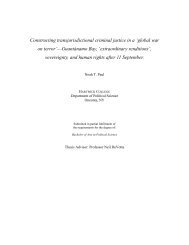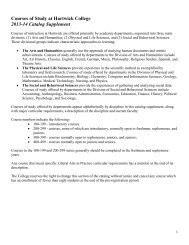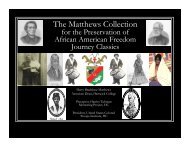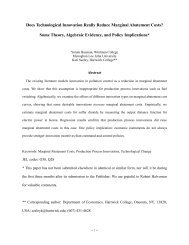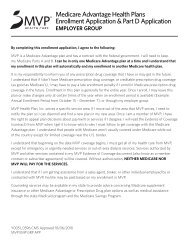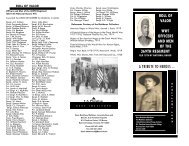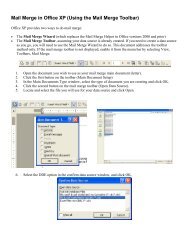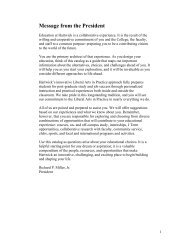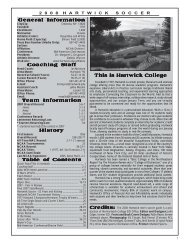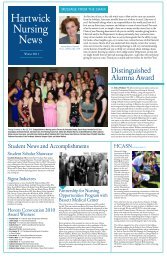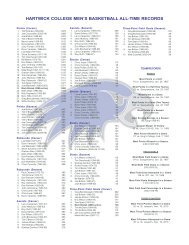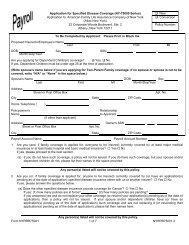Table of Contents - Hartwick College
Table of Contents - Hartwick College
Table of Contents - Hartwick College
Create successful ePaper yourself
Turn your PDF publications into a flip-book with our unique Google optimized e-Paper software.
Culture.” Offered occasionally. Prerequisites depend on the topic. Please see<br />
schedule for current <strong>of</strong>ferings and curriculum XXI designations.<br />
262 Sculpture I (4 credits) The course teaches basic skills in sculptural<br />
processes and introduces students to the language and concepts<br />
associated with sculpture. Students make sculptures using the following<br />
processes: modeling (clay, wax, and plaster), carving, mold-making<br />
(plaster, silicone and latex), metal fabrication and lost wax bronze casting.<br />
Prerequisite: Art 165.<br />
264 Foundry (4 credits) The focus <strong>of</strong> this course is to explore and<br />
execute sculptural forms cast in bronze using the ancient technique <strong>of</strong> lost<br />
wax casting. All students participate in foundry operating procedures.<br />
(CPA)<br />
270 Worldwide Ceramics (4 credits) Students study and research<br />
selected examples <strong>of</strong> functional and non-functional ceramics and clay<br />
artifacts from different countries and cultures, dating from 4500 BCE to<br />
contemporary times. The focus <strong>of</strong> the course is on Pre-Colombian handbuilt<br />
ceramics from Mexico, Central America and South America; works<br />
from China and Japan, and Native American ceramics also are studied.<br />
Besides studying the works from a historical point <strong>of</strong> view, students<br />
actually make, decorate and fire ceramic hand-built forms, which<br />
replicate those examined in the lectures. Several field trips complete the<br />
course. Open to all students. (NTW)<br />
271 Ceramics I (4 credits) The plastic characteristics <strong>of</strong> clay are<br />
explored through experiments in construction, throwing on the potter’s<br />
wheel, hand building and other means <strong>of</strong> fabrication. Students<br />
experiment with mass, color, and texture in functional and non-functional<br />
objects. Participants learn to operate kilns and to maintain the studio and<br />
the equipment. (CPA)<br />
276 Glass I (4 credits) This course focuses on the introduction <strong>of</strong> glass as a<br />
material for artistic expression, as well as elementary technical skills for working<br />
with hot glass. Students will be introduced to the basics <strong>of</strong> glass blowing, the<br />
history <strong>of</strong> glass, and other processes used in glass making. Aesthetic and<br />
conceptual ideas associated with object making will be presented and discussed.<br />
Students will explore the properties <strong>of</strong> molten glass to develop basic skills and to<br />
begin to discover the possibilities <strong>of</strong> personal expression. Prerequisite Art 165 or<br />
equivalent and permission <strong>of</strong> instructor.<br />
301 Greek & Roman Art History (3 credits) The study <strong>of</strong> ancient art<br />
begins with Bronze Age civilizations from around the Aegean Sea and<br />
continues to the age <strong>of</strong> Constantine, around C.E. 315. Course content<br />
includes architecture, painting, sculpture, ceramics and minor arts, all<br />
studied in relation to the philosophies and histories <strong>of</strong> the civilizations<br />
that produced them. Offered alternate years. (WHS or CPA)<br />
302 Medieval Art History (3 credits) The course assesses iconographic<br />
and stylistic developments in Christian art from the Late Antique/Early<br />
Christian period through Romanesque and Gothic. Monuments from<br />
Western Europe as well as Byzantine and Islamic art forms will be<br />
examined. Documenting changes in architectural principles, in elaborate<br />
pictorial programs and in preferences for certain media serves as evidence<br />
for understanding the particular circumstances surrounding the execution<br />
<strong>of</strong> the works. Offered alternate years. Prerequisite: Art 102 or Art 103.<br />
48



